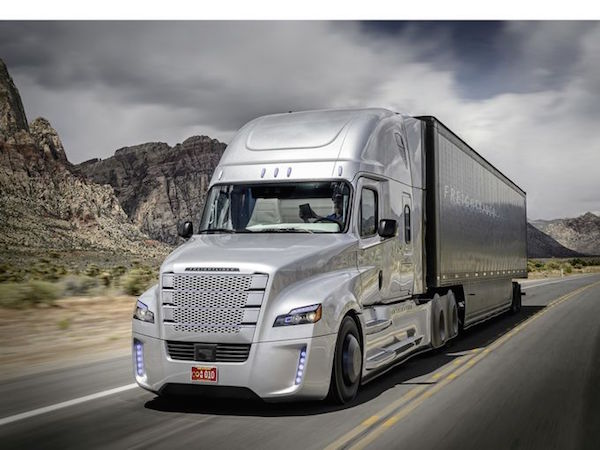Self-driving trucks have been in basic test mode for several years now — meaning a human is present behind the wheel — but now Florida moving toward full auto.
The founder of Starsky Robotics, Stefan Seltz-Axmacher, appeared on Fox Business recently and remarked, “We’ve been testing on Florida roads with people in the cab for couple of years. We’re now gearing up to take the person completely out of the cab on public roads in the state of Florida.”
Still, the Starsky boss says is is not ignorant of the job threat posed by self-driving vehicles, as he described in a June 11 interview:
Seltz-Axmacher explained to Freightwaves, “While others are trying to build fully autonomous trucks, we are building a truck that drives with no person in it and is remote-controlled for the first and last mile and that’s a completely different mindset. We are not eliminating drivers’ jobs. Instead, we are moving them from a truck to a safe and comfortable office where they utilize years of their long-haul trucking experience, but remain close to their families and go home between shifts.”
Perhaps. We’ll see how long that strategy lasts when other companies compete with cheaper hauling rates by deleting drivers entirely.
Below, a Daimler self-driving truck near Hoover dam in 2015.

I thought that trucking would go first for the intermediate strategy of platooning, where a driver pilots the lead truck with two or three vehicles following electronically. But Starsky is going for the big enchilada of full automation straight away. Perhaps they want the publicity of being first.
Keep in mind that driving is a major employment category for Americans. A 2015 Department of Commerce study said that one in nine US workers is employed as a driver:

So Washington won’t need to import any immigrants to work as drivers, since
Automation Makes Immigration Obsolete
Here’s a report from central Florida about the self-driving trucks:
Driverless big rigs could be hitting Florida highways next year. Are you ready, good buddy?, Orlando Sentinel, June 13, 2019
Driverless semi-trucks could be sharing Florida highways as early as next year, and there will be no requirement that surrounding motorists know it.
Nor will autonomous driving systems need to be tested, inspected, or certified before being deployed under a new state law that takes effect July 1.
10-4?
Starsky Robotics, a San Francisco-based startup company that’s been testing its driverless trucking technology in Florida and Texas, has put out a call for job applicants who one day want to pilot big rigs remotely.
Starsky envisions its remote drivers logging onto computers in an office environment to take the reins of its trucks during the first and last miles of their long hauls.
That means the trucks will be on autopilot for the vast majority of their highway journeys.
Driverless deployments should begin in Florida by the end of 2020, Starsky says.That’s much sooner than 2027, the year consulting firm McKinsey & Company projects fully driverless trucks will be ready to hit the highway.
This brave new world is brought to you by a new state law authorizing driverless transportation networks to operate on public roads without the presence of human drivers in the vehicles.
On Thursday, Gov. Ron DeSantis signed the bill enacting the law in a ceremony at SunTrax, the state’s new autonomous vehicle testing track in Auburndale.
While the law will also open the door for ride-sharing companies such as Uber and Lyft to deploy fleets for commuter use, DeSantis’ signing ceremony was staged in front of a Starsky-branded semi-truck. Starsky demonstrated its technology during the event, the company said.
Co-sponsored by Rep. Jason Fischer, a Duval County Republican, and Sen. Jeff Brandes, R-St. Petersburg, the new law replaces an existing one that required a human driver be present and able to take over driving chores in autonomous vehicles operating on public property for any other reason than testing.
Brandes, Fischer and other proponents of driverless vehicle technology say automated systems will make transportation safer by removing the potential for human error. Driverless technology proponents envision a day in the not-too-distant future in which most driving becomes automated, freeing commuters to stare into their smartphones or their dashboard video screens.
Safeguards in the new state law are limited.
Companies will be allowed to deploy their systems with no state inspection or certification.
“Companies [that] wish to operate in the state can do so as long as they are in compliance with any applicable federal regulations and the insurance requirements outlined in state law,” said Beth Frady, communications director for the Florida Department of Highway Safety and Motor Vehicles.
Owners of autonomous commercial vehicles will be required to carry at least as much liability insurance as the state requires for commercial vehicles driven by humans. Currently, that means a minimum level of $300,000 in combined bodily liability and property damage coverage for trucks with a gross vehicle weight of 44,000 pounds or more, and lesser amounts for lighter vehicles.
Autonomous vehicles used for “on-demand” networks must be covered for at least $1 million for death, bodily injury and property damage, the law states.
Autonomous vehicles also will be required to achieve what’s called “minimal risk condition” — such as coming to a complete stop and activating their hazard lights — if their operating systems fail.
Existing traffic laws requiring drivers to promptly notify law enforcement agencies of crashes and then remain on scene to provide information or render aid will be exempted if law enforcement is notified by a vehicle’s owner or by the vehicle’s automated system.
After a Senate committee hearing in March to consider the new law, Sen. Janet Cruz, D-Tampa, prevailed in her push to require owners of autonomous vehicles to carry insurance and be held responsible when vehicles fail to operate as intended.
But she was unsuccessful in her call for a requirement for some sort of signal to passengers and surrounding motorists that the vehicle is operating in the autonomous mode. (Continues)